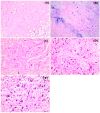What Is the Prognostic Value of the Pathologic Response after Neoadjuvant Radiotherapy in Soft Tissue Sarcoma? An Institutional Study Using the EORTC-STBSG Response Score
- PMID: 39456543
- PMCID: PMC11506461
- DOI: 10.3390/cancers16203449
What Is the Prognostic Value of the Pathologic Response after Neoadjuvant Radiotherapy in Soft Tissue Sarcoma? An Institutional Study Using the EORTC-STBSG Response Score
Abstract
Background/Objectives: The relationship between pathologic findings in soft tissue sarcoma (STS) after neoadjuvant treatment and oncological outcomes remains uncertain due to varying evaluation methods and cut-off values. This study aims to assess pathologic findings after neoadjuvant radiotherapy in STS using the EORTC-STBSG response score and evaluate its prognostic value. Methods: Clinical and outcome data from 44 patients were reviewed. Resected specimens were re-evaluated to measure viable cells, necrosis, fibrosis, and hyalinization. Local recurrence-free survival (LRFS), distant metastasis-free survival (DMFS), and overall survival (OS) were analyzed using Kaplan-Meier survival analysis. Cox proportional hazards regression was used for univariate and multivariate analyses to correlate outcomes with pathologic response. Results: The median percentages of viable cells, necrosis, and fibrosis/hyalinization were 20%, 11%, and 40%, respectively. A pathologic complete response (pCR), defined as ≤5% viable cells, was achieved in 25% of cases. Local recurrence occurred in 33% of cases, with a significantly higher rate of 64% after R1 resection compared to 22% after R0 resection. Distant metastases were observed in 42% of patients, primarily in the lungs. The 3-year rates for LRFS, DMFS, and OS were 65%, 54%, and 67%, respectively. A correlation between outcomes and tumor size, grade and histological subtype was observed. Classifying pathologic response by the EORTC-STBSG score failed to show an association with outcomes. Patients achieving pCR showed lower risk of LR and improved OS. Conclusions: While the EORTC-STBSG score did not show a prognostic value, resection specimens with ≤5% viable cells were linked to improved LRFS and OS.
Keywords: EORTC response score; neoadjuvant radiotherapy; pathologic response; preoperative radiotherapy; soft tissue sarcoma.
Conflict of interest statement
The authors declare no conflicts of interest.
Figures


Similar articles
-
Histologic Appearance After Preoperative Radiation Therapy for Soft Tissue Sarcoma: Assessment of the European Organization for Research and Treatment of Cancer-Soft Tissue and Bone Sarcoma Group Response Score.Int J Radiat Oncol Biol Phys. 2017 Jun 1;98(2):375-383. doi: 10.1016/j.ijrobp.2017.02.087. Epub 2017 Feb 24. Int J Radiat Oncol Biol Phys. 2017. PMID: 28463157
-
Histopathological tumor response following neoadjuvant hyperthermic isolated limb perfusion in extremity soft tissue sarcomas: Evaluation of the EORTC-STBSG response score.Eur J Surg Oncol. 2018 Sep;44(9):1406-1411. doi: 10.1016/j.ejso.2018.05.011. Epub 2018 May 16. Eur J Surg Oncol. 2018. PMID: 29858098
-
Correlation of radiological and histopathological response after neoadjuvant radiotherapy in soft tissue sarcoma.Acta Oncol. 2023 Jan;62(1):25-32. doi: 10.1080/0284186X.2023.2166427. Epub 2023 Jan 13. Acta Oncol. 2023. PMID: 36637511
-
Neoadjuvant Radiation in High-Grade Soft-Tissue Sarcomas: Histopathologic Features and Response Evaluation.Am J Surg Pathol. 2022 Aug 1;46(8):1060-1070. doi: 10.1097/PAS.0000000000001922. Epub 2022 Jun 3. Am J Surg Pathol. 2022. PMID: 35687332
-
Current trials and new aspects in soft tissue sarcoma of adults.Cancer Chemother Pharmacol. 2002 May;49 Suppl 1:S4-8. doi: 10.1007/s00280-002-0445-3. Epub 2002 Apr 16. Cancer Chemother Pharmacol. 2002. PMID: 12042982 Review.
Cited by
-
Rethinking the Prognostic Role of Necrosis in Soft-Tissue Sarcoma: Multidisciplinary Insights from the Sarcoma Academy.Cancers (Basel). 2025 May 26;17(11):1779. doi: 10.3390/cancers17111779. Cancers (Basel). 2025. PMID: 40507260 Free PMC article.
References
-
- Gronchi A., Miah A.B., Dei Tos A.P., Abecassis N., Bajpai J., Bauer S., Biagini R., Bielack S., Blay J.Y., Bolle S., et al. Soft Tissue and Visceral Sarcomas: ESMO–EURACAN–GENTURIS Clinical Practice Guidelines for Diagnosis, Treatment and Follow-Up. Ann. Oncol. 2021;32:1348–1365. doi: 10.1016/j.annonc.2021.07.006. - DOI - PubMed
-
- von Mehren M., Kane J.M., Agulnik M., Bui M.M., Carr-Ascher J., Choy E., Connelly M., Dry S., Ganjoo K.N., Gonzalez R.J., et al. Soft Tissue Sarcoma, Version 2.2022, NCCN Clinical Practice Guidelines in Oncology. J. Natl. Compr. Cancer Netw. 2022;20:815–833. doi: 10.6004/jnccn.2022.0035. - DOI - PMC - PubMed
-
- O’Sullivan B., Davis A.M., Turcotte R., Bell R., Catton C., Chabot P., Wunder J., Kandel R., Goddard K., Sadura A., et al. Preoperative versus Postoperative Radiotherapy in Soft-Tissue Sarcoma of the Limbs: A Randomised Trial. Lancet. 2002;359:2235–2241. doi: 10.1016/S0140-6736(02)09292-9. - DOI - PubMed
LinkOut - more resources
Full Text Sources

